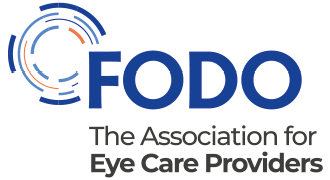09 February 2018
Short Interview with new BCLA President Keith Tempany
FODO’s James Turner spoke recently to Keith Tempany about his priorities as the new BCLA
President after the organisation recently moved into its new home at Gloucester Terrace, joining FODO, the FMO and ABDO. Here’s what Keith had to say…
James: “Hello Keith and a warm welcome from FODO members – many of whom already know you as a pioneering and highly-respected member of the optical community.
“You gave an inspiring call to action in your presidential address on 21 September 2017. Could you set out the main issues you discussed again for FODO members?”
Keith: “Sure. There have been a number of revolutionary moments affecting the contact lens world over the last 40 years, and I believe the next of these will be centred around myopia control. This is currently a huge ticking time bomb for public health that very few people are aware of. What’s more, the idea that there is a so-called ‘safe myopia’ has been blown out of the water by Ian Flitcroft’s *paper on the aetiology of the condition. It’s now clear that even low-level myopia carries health risks and we have to understand that the more myopic people become, the greater the risk of sight-threatening effects.
“Timing is everything in tackling this challenge and we should be looking to step in with treatment
from a younger age than we are currently. This means having conversations with young parents, especially where one or two of them are myopic themselves. For these individuals, we should be making sure we see their children at six months, whether or not they are not showing signs of short-sightedness.
“Even for parents with no history of myopia, we really should be seeing their children before they start school, as those between the ages of six and seven who present with a less plus prescription than they should have are at greater risk of developing myopia further down the line. Studies have shown that it is the year of two before becoming myopic that the eye changes shape the quickest. In cases where a child does become myopic, we need to be proactive, as most of the damage is done between the ages of 6-13. After then it can be too late. Despite an awareness of myopia and the risks, actions are being taken too late. We need to be more on the ball. If we in the optical community don’t believe all of the research on myopia, we at least need to have the conversation.
“What’s clear is that myopia is too massive a problem for one organisation to solve. And so, optical bodies need to come together to educate the public and to provide a unified voice and a unified strategy. We all have a duty of care, and myopia control is part of this. Although we still don’t know very much about myopia, we know far too much to sit back and do nothing. It hasn’t reached the public in a big way yet, but it will”
James: “What is your view of the contact lens sector – what does it do well, and how can it be better?
Keith: “The industry-led education in the sector is excellent and the BCLA is a big part of this. However, as a sector, we need to be comfortable talking to patients after eye examinations and offering them all possible options, including contact lenses. Contact lenses can be lifechanging. We hear it so many times from many individuals, but it’s worth remembering.
“We also need to get more comfortable fitting children with contact lenses. Even for an adult, a contact lens fitting might seem like a daunting prospect, so it’s no surprise that children may feel apprehensive. To serve children effectively, the fitting needs to be a continuation of care based on trust. For instance, it’s really helpful before starting out with any treatment, to get a good buy klonopin 2 mg understanding of the child’s individual likes and dislikes and to tailor the first session with a child accordingly. If you get a lens on the eye that’s a bonus, but it’s really just about building a rapport with the child at that stage, and most importantly, establishing trust.
“To do this, it helps to speak to children not from up high, but at their eye level and to use short sentences and phrases. This is a communication skills challenge, especially given that it’s also part of an ongoing conversation between the optician and the parent, as well as the child. The patient is the priority, of course, and we want them to feel able to ask questions and not feel intimidated. An example we’ve seen of making it fun for children is in using dyes. Instead of just telling a child that you’re going to put dye in their eye, which can understandably make them nervous, you can instead tell them that you’re going to use drops that they won’t feel to give them yellow dragon eyes for a few minutes. It’s just one example, but I’ve seen it done myself, and children love it. This sort of approach really helps to break the ice.
“When it comes to talking to parents, the approach is obviously slightly different, and there’s a fine balance between making them aware of risks and yet not overly scaring them – we can explain about the risk of vision loss without the need to show lots of nasty pictures, for example. Fitting lenses is not difficult. What is a challenge is the communication process.”
James: “Is the Opticians Act (as amended 12 years ago) still fit for purpose?”
Keith: “When it was written, the optical marketplace was totally different from how it is now. The scope of eye care professionals has changed a great deal since then and will continue to change in the near future. A review is absolutely necessary, and any new Act should be future-proofed in order to protect patient safety in years to come. It would also need to promote fairness in the industry to ensure that no grey areas could be exploited.”
James: “What are the current priorities for the BCLA and your presidency?”
Keith: “It’s funny, I never thought I would be President. When I first joined the BCLA Council almost ten years ago, I was really pleased just to be able to give something back to a profession that I loved, and I feel the same way now. And so, I don’t want to just turn up and chair meetings, I really want to see real change take shape during my tenure. For me that chiefly concerns the control of myopia. By the end of my time here, I want the issue to be out there in the public domain and also for the optical profession to be raised up a notch or two in the public consciousness.
Dry Eye Disease is also really important for the BCLA. In fact we have recently completed a dry eye accreditation and will be doing the same for myopia management this year, so I would really encourage practitioners to get up to speed on the subject – not just contact lenses but also the anterior surface.”
James -“Finally, if you have one message for FODO members, what would it be?”
Keith: “Join the BCLA! Come to our conference, keep up to date with the anterior surface and contact lenses and let us help you grow your business!”
FODO would like to thank Keith Tempany and the BCLA for this interview and wish Keith every success for his Presidency and with the myopia campaign.
For more information, contact James Turner [email protected], or Cheryl Donnelly [email protected] .
*Ian Flitcroft’s paper, entitled ‘The complex interactions of retinal, optical and environmental factors in myopia aetiology’ can be found here: https://www.ncbi.nlm.nih.gov/pubmed/22772022

Stay up to date
Subscribe to
our newsletter
Get eye sector updates directly to your email inbox by signing up to our newsletter.
You can inform us at any time if you'd like us to stop sending you these communications.
Press enquiries
Media enquiries should be directed to [email protected] or call 020 7298 5151.
We are happy to put you in touch with our expert policy advisers who can comment on a variety of issues.

 Patients and public
Patients and public
 Policymakers
Policymakers Members
Members News and views
News and views
